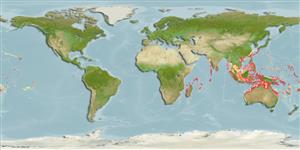>
Carangiformes (Jacks) >
Carangidae (Jacks and pompanos) > Caranginae
Etymology: Caranx: French, carangue, the name of a Caribbean fish; 1836 (Ref. 45335).
More on authors: Alleyne & MacLeay.
Environment: milieu / climate zone / intervalo de profundidade / distribution range
Ecologia
marinhas; estuarina associadas(os) a recifes; não migratória; intervalo de profundidade 1 - 50 m (Ref. 89972). Tropical; 31°N - 34°S, 26°E - 135°W
Indo-Pacific: Zanzibar, Tanzania and South Africa to Caroline and Marquesan islands, north to the Ryukyu Islands, south to Australia.
Tamanho / Peso / Idade
Maturidade: Lm ? range ? - ? cm
Max length : 88.0 cm TL macho/indeterminado; (Ref. 9710); common length : 55.0 cm FL macho/indeterminado; (Ref. 3287); peso máx. Publicado: 6.4 kg (Ref. 4699)
Espinhos dorsais (total) : 9; Raios dorsais moles (total) : 21 - 23; Espinhos anais: 3; Raios anais moles: 16 - 19. Brassy to yellowish green dorsally, shading to silvery on side with scattered dark spots (becoming more numerous with age), conspicuous silvery white spot just behind upper rear edge of opercle, dusky upper caudal fin lobe, and bright yellow to dusky lower lobe with narrow white border (Ref. 90102, Ref. 48635). Body oblong and compressed; dorsal profile moderately convex to second dorsal fin, ventral profile slightly convex. Breast scaleless ventrally, usually with small patch of prepelvic scales. Adipose eyelid weakly developed. (Ref. 90102)
Body shape (shape guide): fusiform / normal; Cross section: compressed.
Inhabit lagoon and seaward reefs, occasionally entering rivers. Juveniles found in estuaries. Swims high over bottom (Ref. 48635). Solitary or in schools (Ref. 90102). Feed primarily on fishes. Excellent food fish (Ref. 12484).
Life cycle and mating behavior
Maturidade | Reprodução | Desova | Ovos | Fecundidade | Larvas
Oviparous, distinct pairing during breeding (Ref. 205).
Paxton, J.R., D.F. Hoese, G.R. Allen and J.E. Hanley, 1989. Pisces. Petromyzontidae to Carangidae. Zoological Catalogue of Australia, Vol. 7. Australian Government Publishing Service, Canberra, 665 p. (Ref. 7300)
Categoria na Lista Vermelha da IUCN (Ref. 130435: Version 2025-1)
Ameaça para o homem
Harmless
Utilização humana
Pescarias: pouco comercial; Aquacultura: espécies comerciais; peixe desportivo: sim
Ferramentas
Relatórios especiais
Descarregue XML
Fontes da internet
Estimates based on models
Preferred temperature (Ref.
123201): 24.5 - 28.8, mean 27.6 °C (based on 586 cells).
Phylogenetic diversity index (Ref.
82804): PD
50 = 0.5000 [Uniqueness, from 0.5 = low to 2.0 = high].
Bayesian length-weight: a=0.01738 (0.01117 - 0.02704), b=2.96 (2.84 - 3.08), in cm total length, based on LWR estimates for this species & Genus-body shape (Ref.
93245).
Nível Trófico (Ref.
69278): 4.0 ±0.5 se; based on diet studies.
Resiliência (Ref.
120179): Médio, tempo mínimo de duplicação da população 1,4 - 4,4 anos (Preliminary K or Fecundity.).
Fishing Vulnerability (Ref.
59153): High vulnerability (55 of 100).
🛈
Nutrients (Ref.
124155): Calcium = 24.2 [11.1, 46.5] mg/100g; Iron = 0.426 [0.232, 0.830] mg/100g; Protein = 20.3 [18.1, 22.7] %; Omega3 = 0.129 [0.076, 0.224] g/100g; Selenium = 45.2 [22.5, 100.3] μg/100g; VitaminA = 45.9 [14.4, 142.2] μg/100g; Zinc = 0.531 [0.376, 0.785] mg/100g (wet weight);
